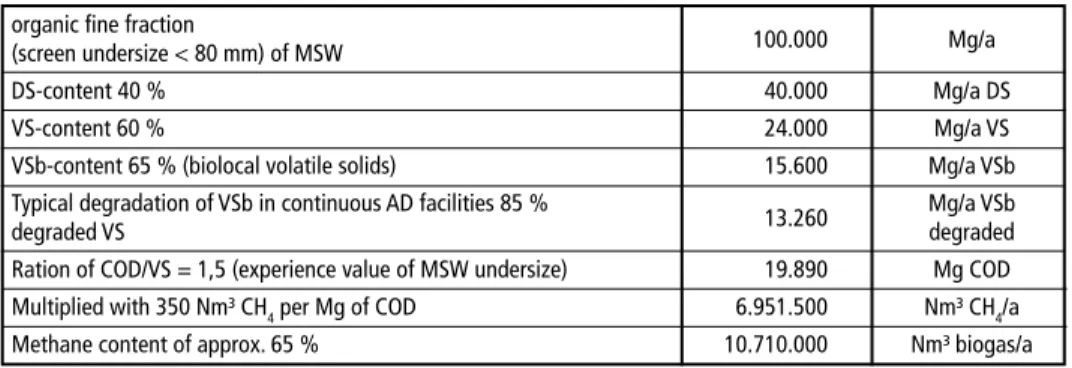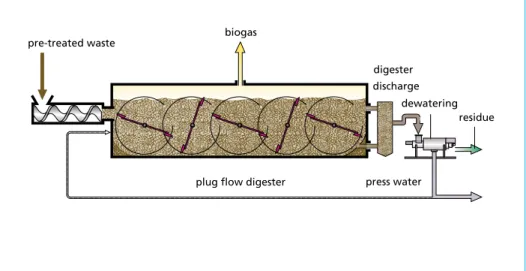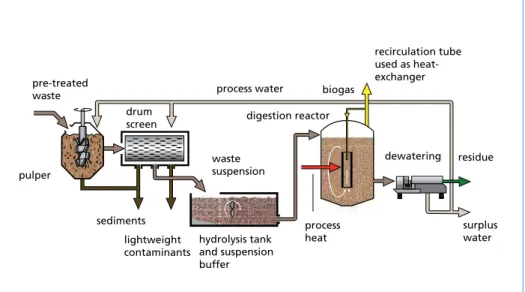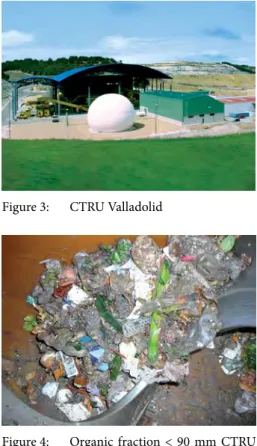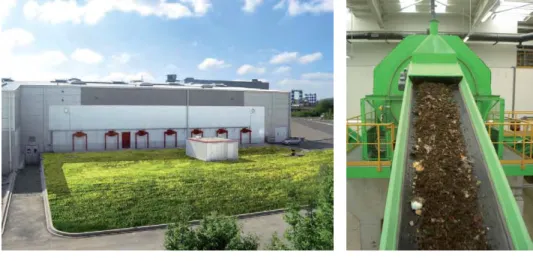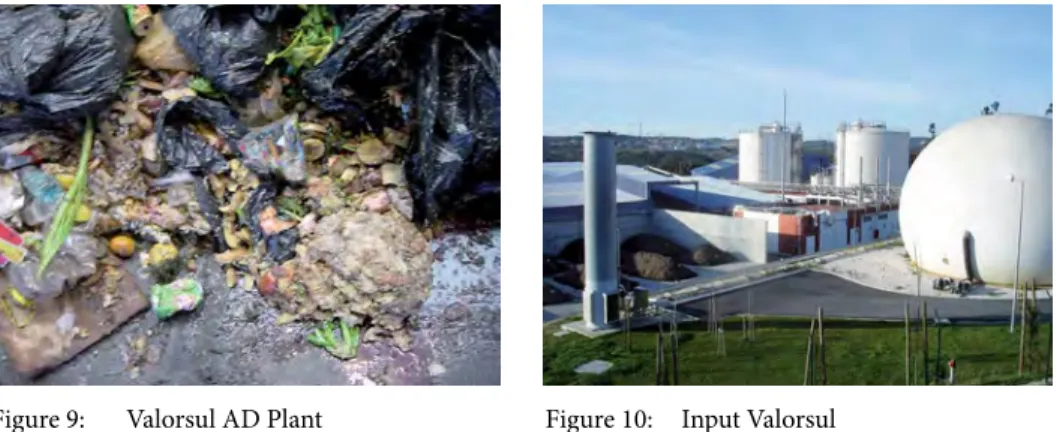Application of Anaerobic Digestion for the Treatment of Municipal Solid Waste in Several Projects
Martin Hagenmeyer
1. What happens in anaerobic digestion processes? ...409 2. What is the energy content of organic household waste? ...409 3. Anaerobic digestion processes ...410 3.1. Continous dry anaerobic digestion in a LARAN-plug flow digester ...411 3.2. Process characteristics and benefits ...412 3.3. Wet anaerobic digestion in a LARAN-loop digester ...412 3.4. Process features and advantages ...413 4. Comparison of operational data and results from different facilities ..413 4.1. Centro de Tratamiento de Residuos Valladolid, Spain –
Dry anaerobic digestion of mixed household waste ...414 4.2. ECOPARC I Barcelona, Spain –
Wet anaerobic digestion of residual waste ...415 4.3. Minett Kompost Mondercange, Luxembourg –
Dry anaerobic digestion of source segregated bio-waste ...416 4.4. Valorsul AD Facility Lisbon, Portugal –
Wet anaerobic digestion of source segregated food and market waste....417 5. Conclusion ...418 6. Literature ...419
In a circular economy there can be no place for waste announced EU Environmental Commissioneer Janez Potocnik in his opening speech for the green week in June 2014 in Brussels. This year´s topic Circular Economy – saving resources, creating jobs showed a clear sign and dedicated this years congress in the opening speech to the circular and resource economy and therewith to the waste management economy. [1]
In the resolutions taken at environmental summit conferences in the last 20 years priority focus was always given to closed circular economy processes to save natural resources and to reduce CO2 emissions, which have their origin in the use of fossile fuels. This aspect has been taken over by the European Union long time ago and the EU directive 1999/31/EC where article 5 considers the limitation of organic materials to be landfilled.
This EU directive 1999/EC/31 has been interpreted differently in several mem- ber countries of the EU and consequently has been converted into national laws differently. Landfill criteria, as criteria for the biological degradation or the remaining biogas potential have been established – within others – by law in different countries.
Further requirements, such as calorific value, TOC, leachate quality, etc. have been introduced.
In order to reach a reduction of organic material in the landfills a big focus has to be layed on the source segregated organic household waste, e.g. bio-waste, food and kitchen waste and industrial organic waste streams such as end of lifetime food waste, food waste from restaurants and big kitchens, …. As one of the leading countries in source segregation of organic household waste Germany has now put forward the obligation for the municipalities to introduce the source segregation of organic waste by October 2015. Actual numbers show that even in Germany more than half of the population is not yet even connected to the source segregation of organic waste and more than a quarter of the waste disposal authorities do not even offer a brown bin to their citizens. Estimations show, that even Germany is already collecting 4.3 million tons of bio-waste there are another 4.3 million tons of bio-waste disposed off together with the residual waste. [3]
In the last years a steadily increasing number of anaerobic digestion facilities for Municipal Solid Waste of other solid waste streams has been built and commissioned.
The main market is still the source segregated organic household waste, so called bio- waste, but especially under the influence of European subsidies many facilities have been built in Spain and Portugal for the treatment of residual waste or mixed household waste. Actual projects with anaerobic digestion are being built in Slovenia, Poland, all over central Europe, in the UK and in the Scandinavian countries. In countries like Germany, the Netherlands, … where the source segregation of organic waste had been introduced about 20 years ago the first composting facilities are now adapted with anaerobic digesters to reach a state-of-the-art treatment of organics in the old composting facilities.
Due to the fact that anaerobic digestion is deemed to be a green and modern process it is socially and politically more acceptable than waste incineration and therefore the planning and permitting processes are shorter and with less difficulties than they are for other thermal or hot processes. Biological Treatment facilities are deemed to work CO2-neutral. Another advantage is that the capital expenditure on mechanical biological treatment facilities is always less than it is for any other thermal or other hot process.
1. What happens in anaerobic digestion processes?
Without entering very deep into the process it is a natural biological process where the carbon in organic substances is degraded and converted into CO2 and CH4 in a fully controlled environment. The biogas mainly consists of CH4 and CO2 and the CH4-content in the biogas typically is in a range of 50-70 percent. Due to the fact that anaerobic digestion is – unlike aerobic composting processes – not an exothermal process the digesters have to be heated to maintain either a mesophilic – approxi- mately 35-37 °C – or a thermophilic – approximately 50-57 °C – temperature range.
Furthermore an anaerobic digestion plant needs certain energy input as a parasitic load, mainly for mechanical stirring, conveying of material, but in total an anaerobic digestion facility always has an energy excess of 50-80 percent and therefore a positive ecological energy balance.
The main use of biogas is still the conversion into electric energy in combined heat and power plants with an electrical efficiency of approximately 40 percent and a thermal efficiency of another 40 percent. Unfortunately not very many anaerobic digestion facilities have heat offtakers, other than the thermal parasitic load of the facility and in these cases the rest of the thermal power gets lost. For this reason more and more plants use biogas upgrading facilities, where the biogas is cleaned and the CO2 is washed out so that the product – called biomethane with a CH4 content of > 97 percent – can be injected into the gas grid or used in compressed form as vehicle fuel, e.g. for waste collection vehicles or any other natural gas operated vehicles.
2. What is the energy content of organic household waste?
When anaerobic processes are balanced a comparatively high amount of analyses and calculations would be necessary to define the way from the very heterogenous organic waste sample to the proportion of digestable organics and the expected stoichiome- trically calculable rate of biogas generation. For this reason a more practical way of balancing such a complex process was developed, which uses the COD as an established cumulative parameter with a largely standardized method of determination.
Evaluating the balanceable oxygen consumption as a theoretical COD oxidation po- tential the rate of generation will on the basis of the molecular volume – oxidation of 22.4 l CH4 equivalent to 2 mol oxygen consumption = 64 g – amount to 0.35 m³ STP CH4 per kg of COD degraded by microorganisms.[2]
Based on the previously mentioned assumption that 1 Mg of COD produces 350 Nm³ CH4 a typical balance for a Municipal Solid Waste Treatment facility would show the following figures:
100,000 Mg/year of organic fine fraction – screen undersize < 80 mm.
The example shows a biogas production of 100.7 Nm³ biogas/t feedstock to the diges- ter, which is an average figure in long term experience for organic fraction of mixed household waste in several projects.
3. Anaerobic digestion processes
Anaerobic digestion processes, which are used for the treatment of solid waste fractions, can roughly be divided in the following types of processes:
• Dry anaerobic digestion with dry solids contents greater than 15 to 18 percent
• Wet anaerobic digestion processes with dry solids contents smaller than 15 percent
• Dry batch processes, characterized by discontinuous processing in batch digesters
• Percolation processes generating an organics loaded process water for digestion in a separate stage.
Whilst the percolation processes have not proven to be suitable for the treatment of solid waste and have nearly disappeared from the markets and the dry batch processes show less biogas production than continuous processes, the dry and wet continuous processes have demonstrated their reliability in many projects in Europe and the rest of the world.
Wet processes are typically used for organic feedstock with a low DS-concentration and a low impurity and contamination level. Typical feedstocks are pure food waste, end of lifetime food and industrial organic waste streams.
Continuous dry processes are typically used for source segregated bio-waste – typical – feedstock in Germany, organic fractions from MSW, co-mingled green and food waste and any other organic feedstocks with an elevated DS-concentration. After the process has proven its reliability in Germany and other countries even agricultural anaerobic digestion facilities for cattle manure, which includes the straw or different silage pro- ducts use dry plug flow digesters for the treatment of these fractions.
Because of their importance for the waste sector the following descriptions and eva- luations are limited to continuous dry and wet processes only.
Table 1: Balancing a complex process – balance for a minimal solid waste treatment facility
organic fine fraction 100.000 Mg/a
(screen undersize < 80 mm) of MSW
DS-content 40 % 40.000 Mg/a DS
VS-content 60 % 24.000 Mg/a VS
VSb-content 65 % (biolocal volatile solids) 15.600 Mg/a VSb
Typical degradation of VSb in continuous AD facilities 85 % 13.260 Mg/a VSb
degraded VS degraded
Ration of COD/VS = 1,5 (experience value of MSW undersize) 19.890 Mg COD Multiplied with 350 Nm³ CH4 per Mg of COD 6.951.500 Nm³ CH4/a
Methane content of approx. 65 % 10.710.000 Nm³ biogas/a
3.1. Continous dry anaerobic digestion in a LARAN-plug flow digester
The STRABAG patented, single step dry anaerobic digestion process was developed for solid waste feedstock with DS-concentrations of 15-45 percent. The principle of this digestion process is based on a plug flow in a horizontal digester. The process can be operated either in mesophilic or thermophilic temperature range and has been used industrially and in municipalities with great success for more than 20 years.
• Compact construction and robustness characterize the design of the digester which is made of either cast on site concrete or precast concrete components.
• The digester is equipped with several transversal paddle agitators in a row in order to reliably prevent the formation of scum layers and sediments, or alternatively to make them manageable. The overlapping arrangement of the paddle stirrers gua- rantees targeted local mixing of the substrate and optimum release of the produced biogas. Each agitator drive only operates intermittently which results in a very low energy consumption.
• All components, such as feeding unit, agitator drives, digester discharge and gas systems are accessible from the outside, making the digesters very service friendly.
• The feedstock is conveyed into the digester by means of a spiral feeding conveyor. If necessary the DS-concentration of the feedstock is adjusted in the first digester cell or in the feeding conveyor. The digester is discharged by a wear resistant vacuum discharge system.
• The digestate is typically dewatered with a screw press or in a two-stage dewatering process with a decanter centrifuge. New concepts – mostly in connection with available excess heat from a waste incinerator or a biomass incineration unit – are using thermal dryers to drive off the moisture of the digestate.
pre-treated waste biogas
digester discharge
dewatering residue
plug flow digester press water
Figure 1: Dry plug flow digester
3.2. Process characteristics and benefits
• High specific biogas yields with uniform biogas production through plug flow cha- racteristics, high VS degradation and continuous operation
• High organic load rate and shorter retention times in contrast to fully mixed dry digesters
• Prevention of scum layers and sediments by means of solely local mixing
• Controlled and minimized sedimentation though overlapping agitators and sedi- ment transport to the digester discharge system
• High operating reliability and availability through multiple individual drives and robust paddle agitators with short and standardized shafts
• Uniform and maintenance free heat transfer through the installation of the heating systems in the digester walls and digester floor
• Flexible selection of different feedstocks with a variable DS-concentration up to 50 percent
• Reliable operation of the digester even at very varying filling levels
• Standardized digester sizes from 900 to 2,600 m³ useable volume.
3.3. Wet anaerobic digestion in a LARAN-loop digester
The wet process for the digestion of organic waste can be operated as a single-stage or a two-stage concept depending on the waste input and the site conditions and can be operated in mesophilic or thermophilic temperature conditions. When operated as a two-stage process the process comprises an in-line set-up consisting of a hydrolysis tank with intermittent aeration – if required – and a downstream methanation digester.
This patented technology with its substrate conditioning process ensures a high process stability an increases the total degradation of organic material. In addition to the hyd- rolisis tank the wet digestion technology is characterized mainly by a wet pre-treatment – either with a waste pulper or a hammer mill pre-treatment – and a downstream impurity separation. The pre-treated waste is mashed and mixed with process water to produce a pumpable suspension suitable for the following wet digestion process. This suspension is passed on into a hydrolysis and buffer tank.
This hydrolysis and buffer tank is designed to provide a buffering function between the waste pre-treatment and the methanation process in order to feed the anaerobic digester as homogenous as possible over the weekends or time periods where the plant is unmanned for any other reason.
The patented loop digester is designed for the recirculation of the material by means of gas injection into a centrally arranged draught tube, which can also be used as a double jacket heat exchanger for the introduction of process heat. A biochemical suppression
of the H2S production is integrated in the digester and carried out by feeding a small amount of air into the draught tube without the addition of any chemicals. The digestate is dewatered by means of decanter centrifuges and certain portion of the process water is recirculated to the pre-treatment process in order to adjust the dry solids content.
pre-treated waste
drum screen
process water biogas
recirculation tube used as heat- exchanger
pulper
sediments lightweight contaminants
hydrolysis tank and suspension buffer
digestion reactor
waste suspension
dewatering residue
surplus water process
heat
Figure 2: Wet loop digester process
3.4. Process features and advantages
• Digestate with a low contamination level due to separation of impurities in the pre-treatment
• High flexibility and adjustment capability for a wide range of feedstocks
• High process stability through a totally mixed digester with high digestion volumes
• High decomposition performance and biogas production by optimized process parameters
• Proven draught tube digester with H2S suppression integrated
• Surface skimmer for scum layer discharge integrated in the digester
• Loop digesters have been built up to 10,000 m³ digestion volume.
4. Comparison of operational data and results from different facilities
The following comparison refers to different facilities in Europe using either dry or wet anaerobic digestion with different feedstocks. The analyzed time periods are in a range of 4 weeks to 1 year to demonstrate the facilities long time biogas production rates. The target of this comparison is to demonstrate the range of biogas production rates and the dependence of the biogas production from the type of feedstock.
4.1. Centro de Tratamiento de Residuos Valladolid, Spain – Dry anaerobic digestion of mixed household waste
CTR Valladolid is an approximately 200,000 t/y composting plant for mixed household waste. It is operated by the UTE Planta de Tratamiento de Valladolid, with its main stakeholder FCC, who is one of the largest Spanish waste management companies. The facility has a 15,000 t/y dry anaerobic digestion plant included. The reason for this was to produce the energy needed for the composting plant within the facility.
Figure 3: CTRU Valladolid
Figure 4: Organic fraction < 90 mm CTRU Valladolid
For this reason a 15,000 t/y organic stream, which consists of screen under- size < 90 mm is directed to the anaerobic digester. The plant was commissioned in 2001 and handed over in 2002 and is in operation since then.
The feedstock to the digester is screen un- dersize < 90 mm and has passed a ferrous and non-ferrous metal separation. Due to the origin of the waste the feedstock still contains very high amounts of impurities.
As there is no separation of hard and heavy particles the percentage of inert impuriti- es, like glass, stones and ceramics is up to 14 percent. The material is fed into the diges- ter as it is, usually with a DS-concentration of 40-45 percent and recirculated process water is mixed in to adjust the dry solids content.
The dewatered digestate cake is mixed with fresh organic waste and is composted in a tunnel composting facility. Impurities and rejects are separated in a compost refining plant.
The conclusion for this approximately 50 days period is that the specific biogas production was 103.44 Nm³ biogas/t feed- stock was produced. The average methane content in this period was 65,5 percent.
The plant is equipped with a CHP engine with an electrical performance of 780 kW.
Table 2: Biogas production in Valladolid Week Digester Biogas/week Biogas/t
input input
35/2008 316 t 28.878 Nm³ 91,39 Nm³/t 36/2008 287 t 32.184 Nm³ 112,14 Nm³/t 37/2008 237 t 32.262 Nm³ 136,55 Nm³/t 38/2008 261,5 t 23.450 Nm³ 89,67 Nm³/t 39/2008 238 t 26.604 Nm³ 111,78 Nm³/t 40/2008 249,5 t 20.891 Nm³ 83,73 Nm³/t
4.2. ECOPARC I Barcelona, Spain – Wet anaerobic digestion of residual waste
ECOPARC I was designed as a 300,000 t/y Residual Waste Facility and a 50,000 t/y composting facility for source segregated bio-waste from the Greater Barcelona Metropolitan Administration. The purpose of the facility was to anaerobically digest the organic fraction of the residual waste and to produce compost from the source segregated organic fraction without anaerobic digestion. The organic fraction from residual waste was expected to be 150.000 t/y. The facility was built in 2001 and 2002 and was commissioned in 2003 and the performance test and acceptance was passed in autumn 2003.
The facility is equipped with 4 wet digesters, each with a liquid digestion volume of 6,700 m³.
The organic fraction was produced in a pre-treatment facility, where the waste was screened at 80 mm and the screen undersize had passed ferrous and non-ferrous metal separation. This fraction was then pre-treated in a pulper pre-treatment and – after a separation of heavies, inerts and light fraction – the suspension was pumped into the hydrolysis buffer tank. The methanation took place in the four digesters and the dewatering was realized in decanter centrifuges.
Even the plant had passed its performance tests and acceptance the wet process has not shown the expected efficiency and reliability for a long term operation with this type of feedstock. After 2 years of operation the plant was decommissioned, adapted to the feedstock requirements and commissioned again. Today one of the four digesters is operated with source segregated organic fraction, whilst the other three digesters are used as storage tanks only.
Figure 5: Digesters ECOPARC I Figure 6: Feed of residual waste into trommel screen
Table 3: Biogas production in Barcelona Week Waste into Biogas/week Biogas/t
pulper input
41/2003 2135 t 263.650 Nm³ 123 Nm³/t 42/2003 1616 t 214.541 Nm³ 133 Nm³/t 43/2003 1428 t 183.932 Nm³ 129 Nm³/t 44/2003 1436 t 155.145 Nm³ 108 Nm³/t 45/2003 1962 t 177.880 Nm³ 91 Nm³/t 46/2003 1379 t 144.042 Nm³ 104 Nm³/t 47/2003 1891 t 146.489 Nm³ 77 Nm³/t
The conclusion for this approximately 50 days period is that the specific biogas production was in an average 109.4 Nm³ biogas/t feedstock with single data in a range from 77 Nm³/t to 129 Nm³/t. The average methane content in this period was 67 percent. The plant is equipped with a CHP plant with 5 MW electrical performance.
4.3. Minett Kompost Mondercange, Luxembourg –
Dry anaerobic digestion of source segregated bio-waste
Minett Kompost is a 30,000 t/y Treatment Facility for source segregated bio-waste. The waste is kerbside collected co-mingled green and food waste in a rural area.
Figure 8: Plant feedstock Minett Kompost
Figure 7: Minett Kompost Mondercange digester
The waste is pre-crushed in a screw mill, ferrous metals are separated and the waste is screened at 90 mm. The screen overflow – approximately 20 percent of the input – is used as structure material for the compost maturation process. The plant is equipped with a two-step dewatering process in screw presses followed by decanter centrifuge.
The dewatered digestate cake is mixed with fresh organic waste and is composted in a tunnel composting facility. Impurities and rejects are separated in a compost refining plant.
Table 4: Biogas production in Mondercange Co-mingled green and food waste
fed to digester 16.952 tonnes
Average daily feed 44,5 tonnes/d
Gas production 2.279.171 Nm³
Average daily gas 5.982 Nm³/d
Average specific gas production 134,4 Nm³/t
Average methane content 56,1 %
Average H2S content 36,4 %
* Mondercange operational data from 1. Oct. 2011 until 15 Oct. 2012
The conclusion for this approximately 1 year period is that the specific biogas production was 134.4 Nm³ biogas/t feed- stock was produced. The average methane content in this period was 56,1 percent.
The biogas is upgraded to biomethane with a CH4-content of > 97 percent and is fed into the national gas grid.
4.4. Valorsul AD Facility Lisbon, Portugal – Wet anaerobic digestion of source segregated food and market waste
The Valorsul AD Facility in Amadora, in the outskirts of Lisbon is a 40,000 t/y Treat- ment Facility mainly for food waste from restaurants and big kitchens and market waste. The market waste fraction with a high level of contamination is pre-treated in a pulper pre-treatment, where impurities are separated as far as possible. The restaurant and other food waste is pre-treated in a hammer mill and directly pumped into the hydrolysis buffer tank.
Figure 9: Valorsul AD Plant Figure 10: Input Valorsul
There are 2 loop digesters with each 4,000 m³ installed. The digestate is dewatered in decanter centrifuges and matured with structure material in a tunnel composting plant.
The hygienization of the material happens as well in the composting/maturation tunnels.
Week Restaurant Market Sum Biogas/week Biogas/t
Waste Waste input
48 338 t 259 t 598 t 90.720 Nm³ 151,7 Nm³/t 49 183 t 349 t 532 t 97.440 Nm³ 183,2 Nm³/t 50 259 t 306 t 565 t 92.400 Nm³ 163,5 Nm³/t 51 301 t 368 t 669 t 102.480 Nm³ 153,2 Nm³/t Sum 2.364 t 383.040 Nm³ 162 Nm³/t
Table 5:
Biogas production in Lisbon
The conclusion for this approximately 4 weeks performance test period is that the spe- cific biogas production was at an average 162 Nm³ biogas/t feedstock in a range from 151 Nm³/t to 183 Nm³/t. The average methane content in this period was 67 percent.
The biogas is utilized in a CHP plant with 2 gas engines of an electrical performance of 835 kW each.
5. Conclusion
As shown in the data of these four examples the gas yields of established processes as used in these four plants depend only on the quality of the organic feedstock. As long as the feedstock is the same continuous dry or wet anaerobic digestion processes are expected to have the same biogas yield. In continuous processes these yields are:
Table 6: Biogas production from different feedstocks
Organic fraction of mixed municipal solid waste in developed countries, characterized by
• high amount of impurities 100-110 Nm³/t
• packaging material and plastics feedstock
• glass and inerts
• 40-50 % DS, 60-70 % VS and 60 % VSb
Source segregated bio-waste, co-mingled green and food waste, characterized by
• low amount of impurities (typically 3-5 %) 130-140 Nm³/t
• higher content of garden and green waste feedstock
• 35-50 % DS, 75-85 % VS and 70-80 % VSb
Source segregated commercial food and market waste, characterized as
• restaurant and big kitchen waste
• market waste 150-190 Nm³/t
• end of lifetime food waste feedstock
• high amount of impurities due to packaging material and plastic bags
• small amounts of garden/green waste
• 20-30 % DS, 75-90 % VS and 80-90 % VSb
Whilst years ago anaerobic digestion technology for all types of municipal solid waste was still seen as unmature technology with certain risk for investors and operators it meanwhile has been established as a reliable, environmentally, friendly sustainable and as well politically and socially acceptable technology for the treatment of organic waste fractions. In Germany alone there are now more than 100 anaerobic digestion plants for source segregated bio-waste in operation. Several plants, especially in southern European countries treat organic fraction from unsorted mixed household waste. There were plants with all types of technologies – dry or wet, continuous or discontinuous and mesophilic or thermophilic – built, all in accordance with investors or operators requirements or special requirements of the project. Anaerobic digestion technology today is deemed to be reliable, environmentally friendly and offers an economic solution.
6. Literature
[1] Langhans, G.: Increasing acceptance of fermentation plants, Linde-KCA GmbH
[2] Wagner, L.: Höhere Recyclingquoten und Deponierungsverbote in einer neuen Kreislaufwirt- schaft in Europa, Fachtagung Kreislaufwirtschaft, Juli 2014 in Würzburg
[3] Witzenhausen Institut: Thesenpapier Weiterentwicklung der Kaskadennutzung von Bioabfall aus Sicht der Bioabfall-Vergärungsbranche
Dorfstraße 51
D-16816 Nietwerder-Neuruppin
Tel. +49.3391-45.45-0 • Fax +49.3391-45.45-10
Bestellungen unter www. .de
oder
Erneuerbare Energien, Band 1
Herausgeber: Karl J. Thomé-Kozmiensky
ISBN: 978-3-935317-44-3
Erscheinung: 2009 Gebundene Ausgabe: 329 Seiten
mit farbigen Abbildungen
Preis: 30.00 EUR
Erneuerbare Energien, Band 4
Herausgeber: Karl J. Thomé-Kozmiensky Michael Beckmann
ISBN: 978-3-935317-55-9
Erscheinung: 2010 Gebundene Ausgabe: 393 Seiten
mit farbigen Abbildungen
Preis: 40.00 EUR
Erneuerbare Energien, Band 5
Herausgeber: Karl J. Thomé-Kozmiensky
ISBN: 978-3-935317-64-1
Erscheinung: 2011 Gebundene Ausgabe: 353 Seiten
mit farbigen Abbildungen
Preis: 40.00 EUR
Erneuerbare Energien, Band 6
Herausgeber: Karl J. Thomé-Kozmiensky Michael Beckmann
ISBN: 978-3-935317-65-8
Erscheinung: 2011 Gebundene Ausgabe: 417 Seiten
mit farbigen Abbildungen
Preis: 40.00 EUR
Erneuerbare Energien, Band 2
Herausgeber: Karl J. Thomé-Kozmiensky Michael Beckmann
ISBN: 978-3-935317-43-6
Erscheinung: 2009 Gebundene Ausgabe: 713 Seiten
mit farbigen Abbildungen
Preis: 40.00 EUR
Erneuerbare Energien, Band 3
Herausgeber: Karl J. Thomé-Kozmiensky
ISBN: 978-3-935317-54-2
Erscheinung: 2010 Gebundene Ausgabe: 366 Seiten
mit farbigen Abbildungen
Preis: 40.00 EUR
Erneuerbare Energien
Erneuerbare Energien, Band 1 • Erneuerbare Energien, Band 2 • Erneuerbare Energien, Band 3 Erneuerbare Energien, Band 4 • Erneuerbare Energien, Band 5 • Erneuerbare Energien, Band 6
115.00 EUR
statt 230.00 EUR
